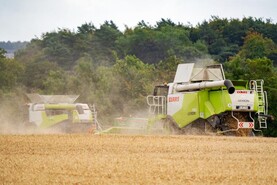The Irish renewable energy sector displaced 6.5m tonnes of CO2 in 2020.
The figures were revealed in the recently published 2020 SEAI National Energy Balance report. The report is the official record of how energy is used in Ireland each year.
By the end of 2020, renewable energy made up 13.2% of Ireland’s energy supply. Wind accounted for over half of all renewable energy produced in the country.
Solar energy (both thermal and photovoltaic) made up just over 1% of renewable energy and just 0.15% of Ireland’s total energy supply. However, a considerable amount of solar farms will be coming online later this year.
Overall, renewable energy generation increased by 8.2% in 2020. Despite the increase, however, the majority of Ireland’s energy supply (86.8%) still came from fossil fuels.
Targets
Ireland reached an overall share of 13.6% renewable energy in 2020, which is below its national EU target of 16%.
The country succeeded in meeting its 2020 transport target (10.2% v a target of 10%) and just missed its national electricity target (39.1% v a target of 40%). It achieved just half its national heat target (6.3% v a target of 12%).
Energy intensity
COVID-19 had a significant impact on national energy use and had a knock-on effect on energy-related CO2 emissions.
Energy-related CO2 emissions (including international aviation) fell by 11.5% (4.3 million tonnes) in 2020, which is the most significant annual reduction since the height of the economic recession in 2009. Total energy consumption fell by 8.8% against a backdrop of a 5.4% contraction of the economy.
The primary driver of this reduction was lower consumption of oil products for transport, which is mainly attributable to the change in national and international travel patterns due to public health measures.
Some of the other key numbers are listed below:
Total transport energy use was down by over a quarter (26%).Oil-product use decreased by 16.5% - the largest annual reduction observed to date.The single largest reduction in oil-product use was the two-thirds drop in jet kerosene use for international aviation (64.3%).Consumption of road diesel and petrol were down 13.6% and 25.9%, respectively.Peat use fell by a third, mainly due to a halving of peat for electricity generation.
The Irish renewable energy sector displaced 6.5m tonnes of CO2 in 2020.
The figures were revealed in the recently published 2020 SEAI National Energy Balance report. The report is the official record of how energy is used in Ireland each year.
By the end of 2020, renewable energy made up 13.2% of Ireland’s energy supply. Wind accounted for over half of all renewable energy produced in the country.
Solar energy (both thermal and photovoltaic) made up just over 1% of renewable energy and just 0.15% of Ireland’s total energy supply. However, a considerable amount of solar farms will be coming online later this year.
Overall, renewable energy generation increased by 8.2% in 2020. Despite the increase, however, the majority of Ireland’s energy supply (86.8%) still came from fossil fuels.
Targets
Ireland reached an overall share of 13.6% renewable energy in 2020, which is below its national EU target of 16%.
The country succeeded in meeting its 2020 transport target (10.2% v a target of 10%) and just missed its national electricity target (39.1% v a target of 40%). It achieved just half its national heat target (6.3% v a target of 12%).
Energy intensity
COVID-19 had a significant impact on national energy use and had a knock-on effect on energy-related CO2 emissions.
Energy-related CO2 emissions (including international aviation) fell by 11.5% (4.3 million tonnes) in 2020, which is the most significant annual reduction since the height of the economic recession in 2009. Total energy consumption fell by 8.8% against a backdrop of a 5.4% contraction of the economy.
The primary driver of this reduction was lower consumption of oil products for transport, which is mainly attributable to the change in national and international travel patterns due to public health measures.
Some of the other key numbers are listed below:
Total transport energy use was down by over a quarter (26%).Oil-product use decreased by 16.5% - the largest annual reduction observed to date.The single largest reduction in oil-product use was the two-thirds drop in jet kerosene use for international aviation (64.3%).Consumption of road diesel and petrol were down 13.6% and 25.9%, respectively.Peat use fell by a third, mainly due to a halving of peat for electricity generation. 





 This is a subscriber-only article
This is a subscriber-only article











SHARING OPTIONS: